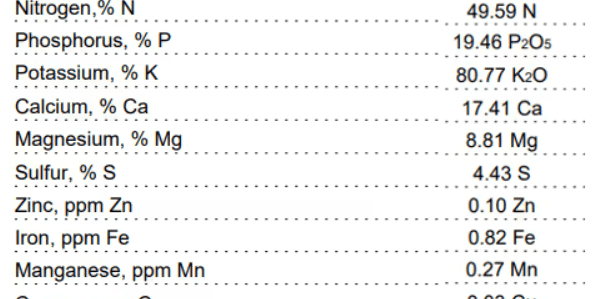When we started Vitalize Seed, we set out to test and quantify our system and results. I knew the science behind the system and I have watched the results with my own eyes on my farm for several years. However, we didn’t think that was enough for our customers. We felt it was necessary to further test and quantify our nutrient sequestration ability to further show how/why our systems reduce fertilizer needs, and create healthier soils – leading to healthier animals!
Tissue testing is time-consuming, tedious, and relatively expensive. We believe that tissue testing is critical if you want to show what is going on in the cover crop, from a nutrient-gathering perspective, and show that your plants are doing the things, you are telling customers they should be doing. This is why we continue to spend time and money on this type of testing throughout the growing season.
We set out to the fields with our square and a pair of scissors on July 15. We gathered our samples and sent them into WARD labs for their cover crop analysis, a few days later- the results were even better than anticipated!
Sample 1:
Nitrogen 49.59lbs per acre
Phosphorus: 19.46lbs per acre
Potassium: 80.77ls per acre
Sample 2:
Nitrogen: 45lbs per acre
Phosphorus: 21.28lbs per acre
Potassium: 74.38lbs per acre
These numbers alone are staggering, but what we must keep in mind is that this is ONLY the above-ground biomass from the Spring cover crop. (Nitro boost). This is also a month before termination, which means this will likely be higher in NPK and Micros, at the time of termination. This C: N ratio is relatively low compared to our fall planting (Carbon Load), which means this is going to break down quickly and allow our fall mix to take full advantage of the above nutrients!!

We also must keep in mind the Organic Matter mineralization rule of 10-30lbs of N per 1% OM. If these fields are 3% OM, we conservatively can figure another 30lbs of N, on top of the N in the above-ground biomass (listed above). The good news is it doesn’t stop there.
We can also consider our root biomass. Plants’ root mass is often where we can have the largest impact on our soils. Our Spring Nitro boost is loaded with legumes, which will be fixing N all summer long, and that N is tied up in the ammonium form in the roots – not accounted for in this bio-mass sample. The roots will also have additional nutrients that will be released as well, after termination – again feeding the fall crop. The last item I want to mention is thatch – these fields still have some thatch on them that is breaking down from last year’s fall (carbon load) planting. This is also not accounted for in our nutrient release but should be mentioned as it will also be feeding this year’s fall planting.
The fields where we have sampled have never had fertilizer put on them. These fields have had lime when needed. They can cycle nutrients and provide ample nutrient availability for the next crop all through nutrient cycling and balanced C: N ratios.

Based on these results, I look forwards to planting my fall crop and continuing to cycle nutrients, feed soil, and feed wildlife without the need for expensive inputs.
Thank you for considering Vitalize Seed. Have a safe and wonderful weekend.
Sincerely-
Albert

